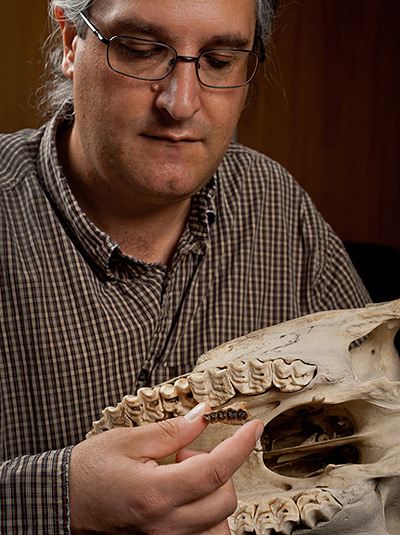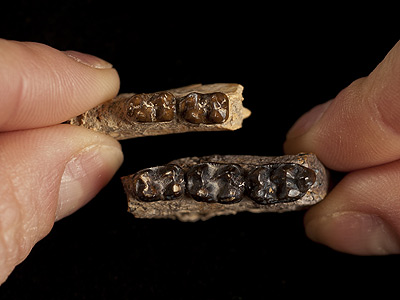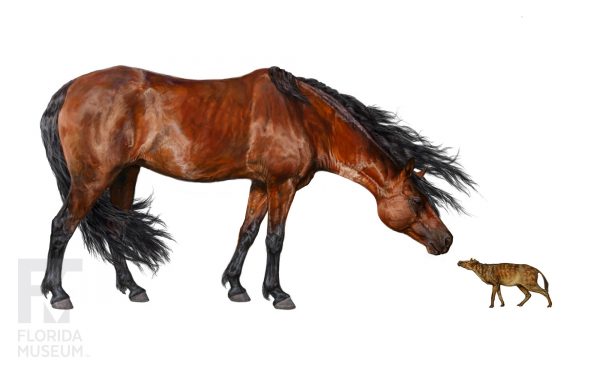These days, climate change is a hot topic.

Florida Museum photo by Kristen Grace
What will happen as temperatures rise more rapidly than humans have documented in modern history? Will birds and mammals flock or will they be able to acclimate? Who will become extinct?
In recent years, scientists have strived to understand the atmosphere’s balance of greenhouse gases to create models that predict rapid climate change, a process humans have accelerated with deforestation and the burning of fossil fuels. Scientists at the Florida Museum of Natural History and anthropology department on the University of Florida campus explored the issue by studying an extreme short-term global warming event known as the Paleocene-Eocene Thermal Maximum that occurred about 56 million years ago.
During this 175,000-year climate event, increased concentrations of carbon dioxide in the atmosphere and oceans caused average global temperatures to rise 10 to 20 degrees.
“The PETM is really important because it marks the beginning for the first appearance of several major groups of mammals, including crown-group primates (ancestors of modern primates) and the first even- and odd-toed modern ungulates (mammals with hooves),” said associate curator of vertebrate paleontology Jonathan Bloch, co-author of a study published in Science Feb. 24, 2012, that correlates temperature with mammalian body size. “This sets the scene for the entire diversity of animals we see on the planet today.”
The study shows how mammals responded to past climate change: As temperatures increased, their body size decreased.
Researchers focused on the evolution of Sifrhippus, the earliest-known horse, which first appeared in the North American fossil record during the Paleocene-Eocene Thermal Maximum. By analyzing the size and isotopes of fossils collected in Wyoming’s Bighorn Basin, researchers traced the evolution of Sifrhippus from an estimated 12-pound animal that shrank during a 130,000-year period about 30 percent to 8.5 pounds, and then increased to about 15 pounds during the next 45,000 years.
“Horses started out small, about the size of a small dog like a miniature schnauzer,” Bloch said. “What’s surprising is that after they first appeared, they then became even smaller and then dramatically increased in size, and that exactly corresponds to the global warming event, followed by cooling. It had been known that mammals were small during that time and that it was warm, but we hadn’t understood that temperature specifically was driving the evolution of body size.”
During the Paleocene-Eocene Thermal Maximum, average temperatures were about 15 degrees Fahrenheit higher than today, and the findings raise important questions about how animals, including humans, might respond to future rapid climate change.
“We’re seeing about a third of the mammals getting smaller and some of them getting a lot smaller, by as much as half of their original body size,” said lead author Ross Secord, who began geochemical analysis of the horse teeth and other mammals, including Coryphodon (a large, hoofed herbivore), as a postdoctoral researcher in Bloch’s laboratory before becoming an assistant professor at the University of Nebraska-Lincoln in 2008. “Because warming happened much slower during the Paleocene-Eocene Thermal Maximum, mammals had more time to adjust their body size. So, it’s not clear that we’re going to see the same thing happening in the near future, but we might.”
Philip Gingerich, who first recorded the phenomenon of decreasing body size during the Paleocene-Eocene Thermal Maximum in 1989, said the study documentation clearly demonstrates the relationship between temperature and body size. He agrees this may occur as a result of current warming patterns.
“I joke about this all the time – we’re going to be walking around 3 feet tall if we keep going the way we’re going,” said Gingerich, a researcher at the University of Michigan and director of its Museum of Paleontology. “Maybe that’s not all bad and if that’s the worst it gets, it will be fine. You can either adapt, or you go extinct, or you can move, and there’s not a lot of place to move anymore, so I think it’s a matter of adaptation and becoming smaller.”
The Fossil Record
Bloch has been collecting fossils in Wyoming’s Bighorn Basin since 1993. He describes the environment 56 million years ago as subtropical, riverine and full of vegetation, a “greenhouse world” with no ice on the poles and alligators and palm trees thriving in the Arctic.

Florida Museum photo by Kristen Grace
“The forests completely changed during the PETM, with plants shifting north about 1,000 miles from the gulf coast to Wyoming in less than 10,000 years,” Bloch said. “It must have been a weird period of time, but it just might teach us something about how plants and animals will respond to climate change in the future.”
Just east of Yellowstone National Park in Wyoming, the Bighorn Basin is traditionally one of the world’s best locations for studying the evolution of mammals during the 20 million years following the extinction of the dinosaurs, Bloch said.
While researchers knew mammals were smaller during that time, the analysis of different-sized Sifrhippus teeth led to the conclusion that temperature was driving their body size. Bloch said the project began about seven years ago when former UF student and study co-author Stephen Chester, now an anthropology doctoral candidate at Yale University, measured horse teeth that seemed too large for their age and became smaller in the younger geologic section.
“Stephen is the one who walked into my office and said, ‘Hey Jon, I think some of these horses are too big to be from the PETM,’ and that observation started the ball rolling for trying to find an explanation for what was going on here,” Bloch said. “I had disbelief initially and thought we must have a sampling issue. But with year after year of collecting new fossils, we started getting bigger and bigger sample sizes illustrating this evolution of body size in the earliest horses.”
The Story in the Bones
After sampling the teeth in the laboratory, Secord worked with study co-author John Krigbaum, an associate professor of anthropology at UF, to conduct isotopic analysis of the specimens.

Florida Museum illustration by Danielle Byerley
“When Ross plotted the oxygen isotope values and tooth size, he immediately realized that temperature appeared to be driving body size,” Chester said. “That was the most exciting moment. I still remember the email because he was so thrilled that there was an inverse correlation between temperature and body size – you just don’t normally see such obvious trends, it’s really rare in the fossil record.”
Researchers also studied possible relationships with aridity and carbon dioxide levels but found temperature to be the most likely driving factor in body size.
“This is the highest-resolution terrestrial record of its kind from anywhere in the world and it shows how climate changed in Wyoming at that time,” Secord said. “When Jon and I started plotting oxygen data from the mass spectrometer, we could immediately see that the shifts in size of horses and temperature were mirror images of each other. That was really surprising because I was expecting much more variability in the oxygen data, but it turned out to be a very significant trend. At that point, we knew we had something very unusual.”
Additional study co-authors include Doug Boyer of Brooklyn College, Aaron Wood of South Dakota School of Mines and Technology and the Florida Museum, Scott Wing of the Smithsonian Institution National Museum of Natural History, Mary Kraus of the University of Colorado and Francesca McInerney of Northwestern University.
Learn more about the Vertebrate Paleontology Collection at the Florida Museum.